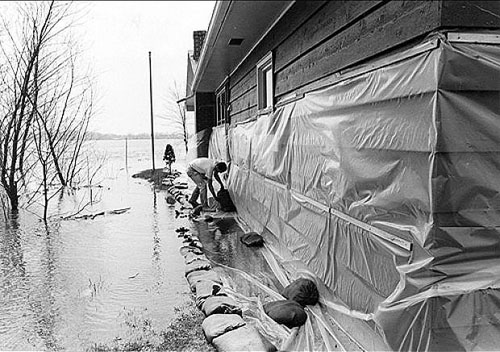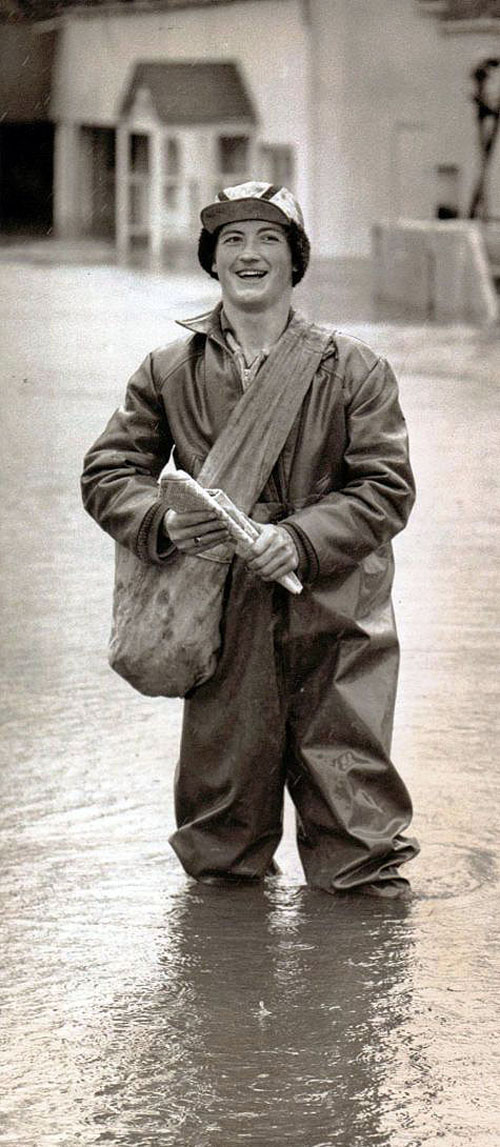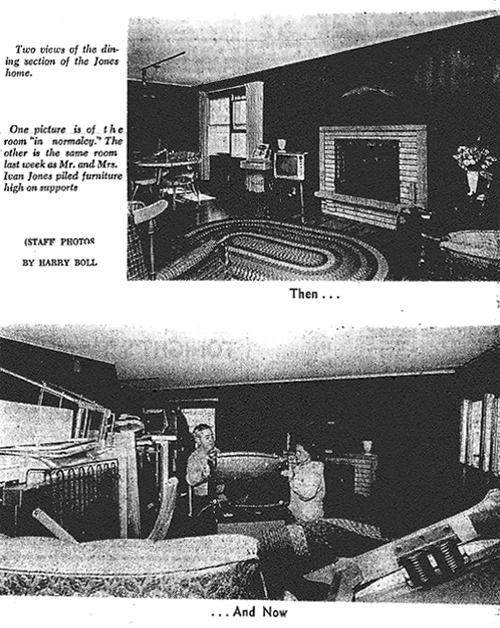Gambles Lost and Won: Scott County Flood of 1965
Davenport, Scott county, Iowa
Jessica Rusick
4/27/1965

In April of 1965, the roads near the Jones’s Pleasant Valley home were under five feet of water. The flood had already forced them to move to their second home in Davenport, but they came back periodically to check how the fortifications on their newly built luxury home were holding. Sandbags, tarps, and boards kept the water in the yard from seeping in, but nothing – not even the two large sump pumps that Mr. Jones and Mrs. Jones put in the crawl space beneath their house – could stop the water coming up through the floors.
“Back in the flood of 1952, long before our house was built, our lot didn’t even go underwater,” said Mr. Jones. Now, thirteen years later, the flood had forced the Joneses to pull up their carpeting, stack their furniture and appliances four feet off the floor, and say a temporary goodbye to their home on the river.

The record-setting flood of 1965 was spurred on by a cold and snowy March, when temperatures dipped 10 to 15 degrees below average and between 40 to 60 inches of snow fell upriver in Minnesota and Wisconsin. The snow melted quickly when temperatures warmed in late March and early April. Since the ground was still frozen, however, the snowmelt ran into waterways instead of soaking into the ground. From April 3 to April 7, up to 3 inches of rain fell across the Mississippi river basin, causing rivers to further overflow their banks. In mid-April, the U.S. Corps of Engineers predicted that the river would crest at 19.5 feet. This was not only significantly higher than the crest of 1952 – it was .1 foot higher than the all-time record crest set in 1892. At the end of April, after persistent rain and revised predictions, the river would crest at an unthinkable height – 22.48 feet.
As the Jones’s scrambled to protect their home, volunteers and city officials struggled to protect Davenport’s water supply. If the Iowa American Water Plant was compromised, engineer Karl C. Cesler told the New York Times, tens of thousands of people – many of whom were wading in murky water up to their knees – would be without the clean stuff.
“Water, that’s our big worry now,” Mayor Ray O’Brien said. “We might get along without other so-called essentials. But not water!” Hospitals in Davenport filled large barrels to prepare for the worst-case scenario, but even those would not be enough to provide water for the entire town. As Cesler asked, “How do you truck water to 90,000 people?”

On April 27, a day before the flood crest, a break in the dirt levee surrounding the water plant could have been catastrophic. Luckily, volunteers were there to repair the damage and patrol the area overnight.
The Jones’s home, however, did not escape damage. After the flood, Mr. Jones and Mrs. Jones returned to a house where the doors wouldn’t close and the floors “bowed up fantastically.” Water, Mr. Jones said, “was running out of the stove.” Although the damage was extensive, all that time spent putting up sandbags, boards, and tarps paid off. “I’ve been in the investment business for years, and I always tell customers not to gamble,” Mr. Jones said. “Well, I guess I gambled myself this time on my house. I can’t say that I’ve totally lost, but I’ve certainly not won.” Still, the Joneses were ready to repair their house, move back in, and gamble again. “I always say, when you end up with a lemon, there’s always one thing you can do – make lemonade.”
Images of the Joneses’ home before and during the flood tell their own story.

